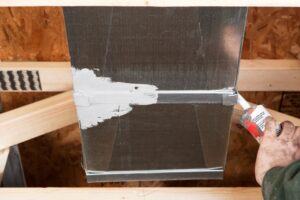People put a lot more thought into heating and air conditioning than they do into ventilation concerns in their homes, despite spending on average over 90% of their time indoors breathing whatever air comes out of their vents. The “V” in HVAC matters, too! Do you know what’s going on with your ducts? Are they causing problems with your indoor air quality? Here’s what you should know.
All About Ductwork
It was about fifty years ago when central air conditioners became all the rage. This meant that new homes had to be built with them in mind, leading to the modern standard of constructing homes with ductwork. But while a house—with proper care and some luck—can stand for centuries, ductwork just won’t last nearly as long.
Residential air ducts can be made of a wide variety of materials. The most common are metal, fiberglass, fiberboard, and flexible ducts made of a metal coil covered in a plastic sheath. They each have their strengths. For example, metal ducts last longer, but fiberboard is less expensive, and flexible ducts can be used in places with limited space or tight corners.
Cracks, Tears, and Leaks
Regardless of the type of ductwork you have in your home, that ductwork has two main enemies. The first is specific damage, which can be caused by anything from drilling through a wall to hang a picture to a rodent infestation. The second is simply the ravages of time. Duct materials will gradually deteriorate, and the constant temperature fluctuation causes expansion and contraction that contribute to that deterioration.
Shockingly, it’s estimated that in the average American home, there are enough cracks, tears, and leaks in the ductwork to allow 30% of the heated or cooled air to escape. That’s 30% of your heating and cooling bills being spent on nothing but waste! It also puts extra strain on your air conditioner and furnace. Late-season AC maintenance can help identify these issues early, preventing wasted energy and costly repairs. And the damaged or deteriorated ducts have serious impacts on your indoor air quality as well.
Air Quality Concerns
We mentioned air leaking out of your ductwork, but the pressure in these systems means that during parts of the heating and cooling cycles, air is pulled in through those cracks and tears as well. It then continues through your ducts to your vents and is blown out into your home for you to breathe. If your AC has started to make strange noises, beware of these sounds—they could indicate deeper duct or ventilation problems.
What could be in that air? Well, it’s coming from unoccupied spaces like your attic and between your walls. It can contain germs from rodents, sawdust, insulation fibers, and more. If that doesn’t sound like something you want to be breathing, we agree with you! For other ways to improve your home’s air, check out how to breathe easier at home. That’s why it’s so important to have your ductwork tested and, if necessary, sealed or repaired.
If you want to find out more about duct repair in Houston, TX and how it can improve your air quality and cut your heating and cooling bills, we’d love to have a conversation with you.
Reach out to Cool Care Heating and Air Conditioning, The Best Care for Your Air.



